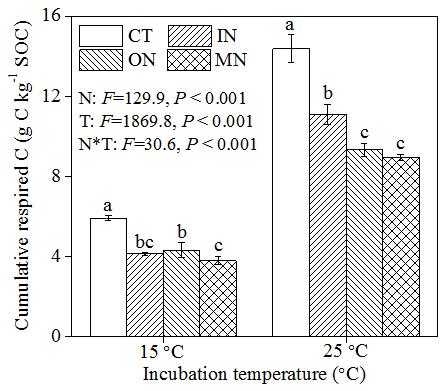
Soil microbial respiration is a key process controlling the size of the soil organic carbon (C) storage and C loss from terrestrial ecosystems to atmosphere. A small change in the rate of soil microbial respiration may have a large effect on the net C flux and climate dynamics because of the largest SOC stored in terrestrial soil systems. Therefore, understanding the response of soil microbial respiration and its temperature sensitivity (Q10) to atmospheric N deposition under global warming is important to improve the accuracy of predicting changes in global C cycles and its feedback to climate change.
In recent years, many works about microbial respiration and its Q10 have been done to investigate the effects of N deposition on soil microbial respiration and its Q10. However, most previous studies used single inorganic or organic N as N resource, which may not actually reflect the effects of atmospheric nitrogen (N) deposition on soil microbial respiration and its Q10 because it indeed contains inorganic and organic N components.
Therefore, to advance the understanding of the responses of soil microbial respiration and its Q10 values to atmospheric N deposition, professor Wang Qingkui and his colleagues from the Institute of Applied Ecology of the Chinese Academy of Sciences conducted an experiment with soils receiving long-term N addition to assess the effects of inorganic and organic N addition on soil microbial respiration and its Q10, and reveal their underlying mechanisms.
Their results highlighted the effects of inorganic and organic N addition on microbial respiration and its potential mechanisms, and implied the necessity of considering N type when predicting soil C cycling and dynamics in the increasing N deposition scenario.
These results were published as the title "Influences of N deposition on soil microbial respiration and its temperature sensitivity depend on N type in a temperate forest "Agricultural and Forest Meteorology".
The work was supported by the National key R & D projects in China, the National Natural Science Foundation of China, and the Strategic Priority Research Program of the Chinese Academy of Sciences.

Fig. 1 Cumulative respired C after 150-day incubation at 15 oC and 25 oC in a temperate forest. CT, IN, ON and MN represent control, inorganic N, organic N and their mixture treatments, respectively. The different letters above the bars represented significant differences among treatments at the same temperature (P < 0.05). (Image by WANG Qingkui)

Fig. 2 The temporal variations of Q10 under different types of N deposition during 150 day incubation in a temperate forest. CT, IN, ON and MN represent control, inorganic N, organic N and their mixture treatments, respectively (Image by WANG Qingkui)

Fig. 3 Contributions of main controlling factors to explaining variations in soil cumulative respired C at 15 oC and 25 oC and its temperature sensitivity (Q10) based on redundancy analysis. NO3 and NH4 present nitrate and ammonium nitrogen; AP presents soil available P; C:N presents the ratio of soil organic C to total N; B:F denotes the ratio of bacterial PLFAs: fungal PLFAs; GP and GN denote gram-positive and –negative bacterial PLFAs, respectively. Cyc:mono, Sat:mono denote ratios of cyclopropyl to monoenoic fatty acids and total saturated to total monounsaturated fatty acids (Image by WANG Qingkui)

86-10-68597521 (day)
86-10-68597289 (night)

86-10-68511095 (day)
86-10-68512458 (night)

cas_en@cas.cn

52 Sanlihe Rd., Xicheng District,
Beijing, China (100864)

